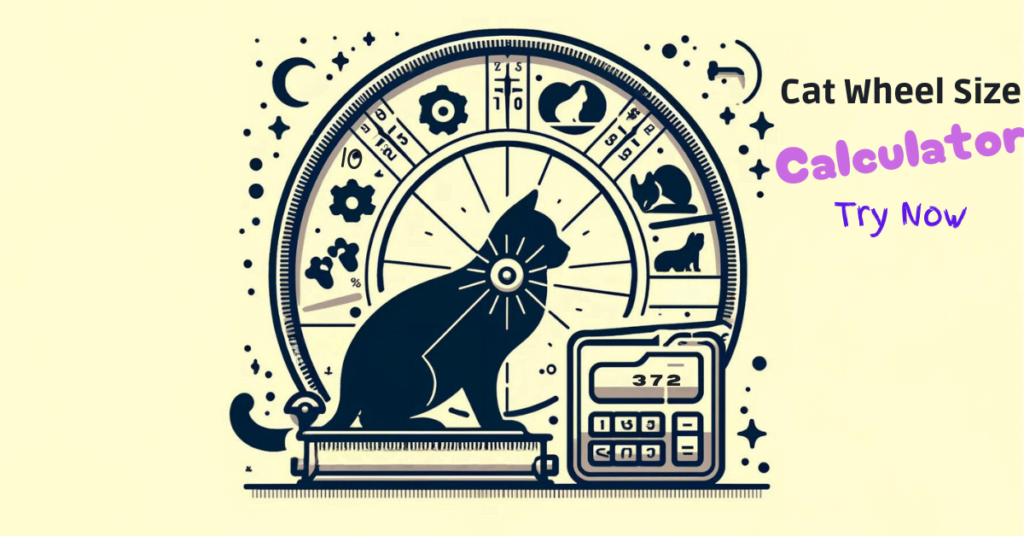This post contains affiliate links and I will be compensated if you make a purchase after clicking on my links.
The Rise of the Cat Exercise Wheel in Modern Pet Care
In a world where the paw-sibilities of technology stretch as endless as a kitty’s curious whiskers, a new entrant has sprinted onto the scene of feline fitness: cat exercise wheels.
These sleek, spinning gadgets embody the perfect fusion of modern tech and feline fervor, inviting our fur-babies to chase not just their tails, but a healthier lifestyle. With every spin, they promise a playground where claws meet cool tech, and whiskers whirl in delight.
Yet, as these wheels whirl into the heart of modern-day catdom, they carry along a furball of a question: “Are cat wheels safe for our furry companions?” As we paw-nder over this modern marvel, it’s time to unravel the twine of safety around these trending treadmills for tabbies, and dive into a kitty investigation that’s both tech-savvy and tail-wagging exciting.
Are Cat Wheels Safe? Key Takeaways
Dive into these key takeaways to quickly scratch the surface of cat wheel safety, and when time permits, pounce on the full article for a deeper understanding.
Potential Risks of Cat Exercise Wheels: Cat wheels smaller than 40 inches may harm a cat’s spine, and improper assembly can lead to accidents. Unsafe placement and lack of safety features like locks can increase risks, while over-training and unsupervised use can cause injury or stress.
Ensuring Cat Safety on Wheels: Safety involves choosing the right size, ensuring sturdy construction, and having smooth edges. It’s important to have a wheel with adequate width, guarded sides, a safety lock, and correct assembly. The wheel should be placed in a safe location, used in moderation, and under supervision.
Cat Wheel Safety Across Breeds: Most cat breeds can safely use exercise wheels with proper introduction and training. Active breeds may adapt more quickly, while heavier or older cats may need more careful training. Adequate size and construction are crucial for all cats.
Age Considerations for Cat Wheels: There are no strict age limits for cat wheels, but kittens and older cats may need special attention. Brachycephalic breeds and low-energy cats may require extra training to use the wheel safely and effectively.
Exercise Sufficiency of Cat Wheels for Indoor Cats: Cat wheels are beneficial for indoor exercise but should be part of a varied routine. They provide physical activity but need to be complemented with other forms of play for mental stimulation and overall well-being.
What are the potential risks of using cat exercise wheels?
Like with any exercise equipment, there are certain potential risks that every tech-savvy cat lover should be aware of. It’s not just about letting the good times roll; it’s about ensuring they roll safely.

1. Incorrect Wheel Size
A cat wheel with a diameter less than 40 inches can be detrimental to your feline friend’s spine, increasing the likelihood of injuries. It’s like fitting a large cat into a tiny box, only less cute and more harmful.
For instance, the Penn-Plax Cat Wheel, with an internal width of 29.5 inches, may not be suitable for larger breeds. Running on a smaller wheel could risk spine compression and other injuries in bigger cats
2. Improper Assembly
Misaligned wheel segments or loosely screwed parts can cause unwanted noises with each rotation, which might startle your cat. An incorrectly assembled wheel can become a clunky menace rather than a smooth-running joy.
3. Unsafe Location
Placing the wheel near fragile items or feeding stations could spell disaster. A cat sprinting full throttle on a wheel near breakables is a scene right out of a slapstick comedy, minus the laughter if it leads to accidents.
4. Lack of Safety Lock Mechanism
Absence of a safety lock can lead to the wheel spinning out of control before your cat is ready for a solo run, potentially causing them to lose their footing and fall.
5. Over-Training
Over-zealous training sessions can lead to exhaustion or muscle strain for your cat, especially if they are unfit or overweight. It’s a wheel, not a whip; overdoing it can lead to fatigue and other health issues.
6. Unsupervised Use
Until fully accustomed to the wheel, unsupervised sessions can lead to misuse or accidents. Your cat may decide to turn the exercise session into a daredevil stunt show, with less than graceful landings.
Understanding these risks assists cat owners in taking the first steps to address the crucial question: Are cat wheels safe?
How Can I Ensure My Cat’s Safety While Using a Cat Wheel?
In the whirlwind of excitement that comes with introducing your cat to a tech-savvy treadmill, safety should be the anchor holding the storm at bay. Here’s how you can ensure your feline friend sprints safely into the realm of modern fitness:
1. Choose the Right Size
A good rule of thumb is to select a wheel with an internal diameter that is more than 1.5 times the size of your cat. This ensures enough space to prevent any risk of spine compression or other injuries, making it suitable for cats of all breeds and sizes.
For more advice on selecting the perfect cat exercise wheel in our article: How to Choose the Right Cat Exercise Wheel.

2. Stable and Sturdy Construction
A wobbly wheel is a recipe for a cat-tastrophe. Ensure the construction is solid, stable, and designed to stay grounded even when your cat is in full sprint mode.
3. Smooth, Snag-Free Edges and Surfaces
The road to feline fitness should be smooth, both literally and figuratively. Check for smooth edges and surfaces to prevent any snags or injuries as your cat races towards better health.
When evaluating the safety of cat exercise wheels, it’s crucial not to underestimate the importance of quality. Check out our post on the best cat exercise wheels to discover the ideal option for your tech-savvy feline companion.
4. Adequate Width and Diameter
Your cat’s natural gait should glide effortlessly on the wheel without stumbling. Ensure the wheel’s width allows for a comfortable stride, preventing any awkward movements that could cause injury. A width of at least 12 inches is usually recommended.
5. Enclosed or Guarded Sides
Guarded sides or an enclosed design can act as a safety bumper, keeping your kitty on track and preventing falls.
6. Safety Lock Mechanism
A safety lock is your cat’s unseen trainer, keeping the wheel stationary during initial training sessions until they are fully ready for solo runs. Models like the Homegroove Cat Exercise Wheel come equipped with this essential feature.

7. Correct Assembly
Follow the assembly instructions to the letter, ensuring every piece of the wheel and frame is tightly screwed in. A well-assembled wheel is the first step towards a safe running experience.
8. Safe Location
Set up the wheel away from fragile objects and feeding stations, preferably near a wall with an 8-12 inch gap, to prevent any mishaps.
9. Moderate Training Sessions
Keep training sessions to a maximum of 10-20 minutes each day, especially if your cat is just starting out or is unfit. Balance is key to preventing over-exertion and promoting a healthy exercise routine.
10. Supervision
As the saying goes, curiosity killed the cat, but supervision brought it back! Especially in the early stages, it’s crucial to monitor your cat while they’re getting the hang of their new exercise wheel. Watch out for any signs of distress, discomfort, or misuse that could potentially harm your furry friend.
Are Cat Wheels Safe for All Cat Breeds?
Exploring if cat wheels are safe across various feline breeds reveals that these cat gadgets can be a secure and stimulating pastime for many cats provided they are introduced and used correctly. Training is essential for all cats to get accustomed to the wheel, with individual personality and energy levels often being more significant factors than breed alone.
However, certain breeds such as Bengals, Savannahs and Maine Coons may take to a cat wheel more naturally due to their active and curious natures.

Heavier-set cats can also safely use the wheel, provided they are under the weight requirements specified by the wheel manufacturer. Ensuring the wheel is of adequate size and sturdily built is crucial for the safety of all cats, regardless of breed.
It may take extra patience and consistent training to motivate cats with lower energy levels, such as brachycephalic breeds like Persian cats, to become accustomed to physical activity, particularly for those that are heavier or older.
Are there any age restrictions for cats using exercise wheels?
There’s no age limit for using a cat exercise wheel, but individual characteristics can influence success. Kittens, while mastering their balance, and older cats, treading more cautiously, each interact differently with the wheel. Interestingly, some senior cats discover a rejuvenated spirit through a gentle trot on the wheel.

Do cat wheels provide enough exercise for indoor cats?
While determining if cat wheels are safe and sufficient for indoor cats, it’s vital to look at their activity needs. Cat exercise wheels offer a purr-fect platform for our fur-coated friends to shed those extra kitty calories and chase an imaginary mouse (or two) in a safe, indoor environment.
For more insights into the benefits, check out our post on the benefits of cat exercise wheels.
However, they aren’t a one-stop solution. Though cat wheels can get the paws moving and hearts pumping, cats also thrive on a mix of exercises that tickle their hunting and playful instincts.
Engaging in a feisty game of “catch the laser dot”, or a jolly jaunt chasing a feather wand, adds a layer of mental stimulation that the wheel might not offer. Plus, climbing cat trees, exploring cat tunnels, or simply a good old game of hide-and-seek can provide a more holistic approach to exercise, fulfilling both their physical and cerebral feline cravings.
So, while cat wheels are a fantastic gear in the engine of indoor cat exercise, they shine brightest when paired with other forms of physical and mental stimulation.
The Final Purr: Safety Verdict on Cat Wheels
In our journey to answer the core question – are cat wheels safe – we’ve discovered it’s all about smart choices and mindful care.
Whether you’re buying a cat wheel or feeling adventurous with a DIY wheel project, the same safety precautions are key. Ensuring the right wheel size, proper training, and a vet’s approval makes cat wheels a safe and healthy option for cats of all ages and breeds.
Frequently Asked Questions?
1. Do vets recommend cat wheels?
Absolutely, vets approve cat wheels for their paw-some benefits: boosting physical activity, fighting boredom, and keeping those kitty waistlines in check. They encourage natural hunting and running instincts, providing a purr-fect outlet for energy in a safe, controlled environment.
2. Do cats actually like cat wheels?
Indeed, many cats are fans of cat wheels, treating them like their personal feline freeways. It taps into their love for chasing and exploring, offering endless fun. However, like humans and exercise bikes, not every cat is a wheel enthusiast from the get-go.
3. Are treadmills safe for cats?
Treadmills can be safe for cats, but they require careful introduction and supervision. Unlike cat wheels designed for feline instincts, treadmills need a slower, more controlled approach to ensure your cat’s comfort and safety.
Meet Sean, a fintech whiz with a penchant for pet purrs and blockchain buzz. After a decade of fintech feats, Sean’s tech talents leaped from ledger lines to litter lines, driven by a passion for pets and a vision for a more connected pet care community. With three critter companions as co-pilots, Sean launched this blog to share a treasury of pet-friendly tech tips and tales.



